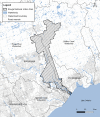Evaluation of headstarting as a conservation tool to recover Blanding's Turtles (Emydoidea blandingii) in a highly fragmented urban landscape
- PMID: 36888589
- PMCID: PMC9994698
- DOI: 10.1371/journal.pone.0279833
Evaluation of headstarting as a conservation tool to recover Blanding's Turtles (Emydoidea blandingii) in a highly fragmented urban landscape
Abstract
Freshwater turtle populations are declining globally as a result of anthropogenic activities. Threats to turtles in urban areas are exacerbated by road mortality and subsidized predators, which can lead to catastrophic shifts in population size and structure. Headstarting is used as a conservation tool to supplement turtle populations that may otherwise face extirpation. A headstarting program began in 2012 to recover a functionally extinct population of Blanding's Turtles (Emydoidea blandingii) 26in Rouge National Urban Park (RNUP), Ontario, Canada. The original population included five adults and one juvenile turtle. From 2014 to 2020, 270 headstarted turtles were released. The population has been monitored annually since 2014 using visual-encounter surveys, radio-telemetry, and live trapping (from 2018 onwards). We used mark-recapture and radio-telemetry data to quantify abundance, survival, and sex ratio of the headstarted turtle population. Using a Jolly-Seber model, we estimated abundance to be 183 turtles (20 turtles/ha) in 2020. Estimated survival of headstarted turtles approached 89%, except for turtles released in 2019 when survival was 43% as a result of a known mass mortality event at the study site. Pre- and post-release sex ratios were not significantly different (χ2 = 1.92; p = 0.16), but shifted from 1:1.5 to 1:1 male:female post-release. Given that the headstarted turtles have not yet reached sexual maturity, it is unclear whether headstarted turtles will reach adulthood and successfully reproduce to maintain a self-sustaining population. Thus, to evaluate the success of the headstarting program, long-term monitoring is required.
Copyright: © 2023 Wijewardena et al. This is an open access article distributed under the terms of the Creative Commons Attribution License, which permits unrestricted use, distribution, and reproduction in any medium, provided the original author and source are credited.
Conflict of interest statement
The authors have declared that no competing interests exist.
Figures





References
-
- Gibbons JW, Scott E, Ryan TJ, Buhlmann KA, Tuberville TD, Metts BS, et al.. The global decline of reptiles, déjà vu amphibians. Bioscience. 2000;50: 653–666.
-
- Spinks PQ, Pauly GB, Crayon JJ, Shaffer HB. Survival of Western Pond Turtle (Emys marmorata) in an urban California environment. Biol Conserv. 2003;113: 257–267.
-
- Gibbs J, Shriver G. Estimating the effects of road mortality on turtle populations. Conserv Biol. 2002;16: 1647–1652.
-
- Marchand MN, Litvaitis JA. Effects of habitat features and landscape composition on the population structure of a common aquatic turtle in a region undergoing rapid development. Conserv Biol. 2004;18: 758–767.
Publication types
MeSH terms
LinkOut - more resources
Full Text Sources

